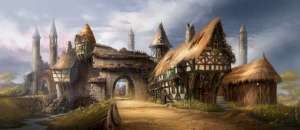So, having described for you the Old World, we move West to describe the lands across the sea.
The first land mass one might come across, sailing West across the Great Sea from the Empire, would be Albion. Albion is a small, mist shrouded Island Slightly to the North West of the Old World, and clearly evokes Celtic Britain in the lore.
Albion is a marshy and subject to constant precipitation. It is inhabited by a few, almost neolithic, tribes, as well as giants, and the Druidic ‘Truthsayers’and their opponents the ‘Dark Emmisaries’. One of which, in a fen, is shown below:
 Arguably the most striking (read:only) feature of the landscape are a series of standing stones known as ‘Ogham Stones’. These were erected by the Truthsayers to hold back the magical force of Chaos in years past.
Arguably the most striking (read:only) feature of the landscape are a series of standing stones known as ‘Ogham Stones’. These were erected by the Truthsayers to hold back the magical force of Chaos in years past.
Beyond the misty Island of Albion lays Ulthuan.Ulthuan is a gigantic Atoll shaped Island series, with a large inland sea. It is the homeland of the High Elves, and was subject to a catastrophic magical event called ‘the Sundering’, which sunk parts of the Island beneath the waves. A map below shows the Island itself:
It is divided up into various regions with distinct terrain, from the lush forests of Averlorn to the foothills and woods of Chrace. The different regions and their unique military contributions to the High Elven armies will be discussed elsewhere. Of note is the Sea Gates of Lothern, which guard the entrance to the inner sea. Below is an image of High Elven troops amongst the foot hills of one of the great mountain ranges that are the spine of Ulthuan:
Beyond the home of the High Elves is the realm of their blighted cousins, Naggaroth, home of the Dark Elves.
Naggaroth is as dark and cruel a land as the twisted Elves who inhabit it. Much of it is bittery cold and virtually uninhabitable. A huge mountain range called the Blackspines make up much of the continent. The mountains are of black stone, and the same black stone forms the building materials for the fortresses of the Dark Elves. As travel is so difficult across land in Naggaroth, the Dark Elves use a series of underground passages to move between their citadels. Below is an image of Naggarond, the great stronghold of the King of the Dark Elves, Malekith:
Only in the South of the continent does the weather become bareable enough to allow gloomy pine forests to take root.
South of Naggaroth lays another continent, known as Lustria. Lustria’s humidity and lush jungle is in stark contrast to the bleak and freezing wasteland to the North. Lustria is the home of a huge range of wildlife, most of which are a danger to explorers of the jungle’s depths. In that sense, in some ways, Lustria is no more hospitable than Naggaroth.
 Lustria is most known for the Lizardmen who have inhabited it since before even the Elves walked the world. The land itself was originally attached to the Southlands (a jungle land below Araby) but were moved to its current position by the ‘Slann’, the Mage Priests of the Lizardmen. A procession of Lizardmen escorting one such Slann through the jungle is shown below:
Lustria is most known for the Lizardmen who have inhabited it since before even the Elves walked the world. The land itself was originally attached to the Southlands (a jungle land below Araby) but were moved to its current position by the ‘Slann’, the Mage Priests of the Lizardmen. A procession of Lizardmen escorting one such Slann through the jungle is shown below:
It is not only inhabited by the Lizardmen though, as, over time, other races have stumbled upon, or made their way to the Steamy shores of the continent. The rat men known as Skaven were the first to arive, and since then other settlements have been created along the coast, somewhat to the chagrin of the Lizardmen, whose temple cities are often the targets of raids by such settlers. One such temple city is shown below, along with the Lizardman army defending it:
The continent has a volcanic mountain range known as the Spine of Sotek. The jungles of Lustria are also criss crossed by waterways, the greatest of which is the Amaxon. Of all places in the Warhammer World, Lustria is home to some of the largest and most vicious wildlife. Many of these are harnessed by the Lizardmen and ridden or driven into battle. The smallest of these is pictured below; the raptor like ‘cold one’ that is used by both the Lizardmen and the Dark Elves as a form of cavalry.
Our journey for today ends with Lustria, our next trip will be to the East and the Southlands. Keep well til then.



















